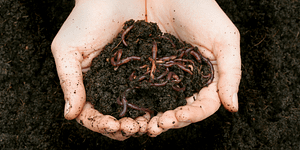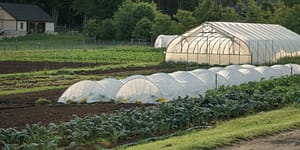Sustainable Food: The Movement Toward This System

Respect for the land, for the worker, and for the value of agriculture are some of the underlying principles of Community Supported Agriculture—an increasingly popular movement that helps connect consumers to the growers of sustainable food and fresh, local, and organic produce.
The following is an excerpt from Sharing the Harvest: A Citizen’s Guide to Community Supported Agriculture by Elizabeth Henderson with Robyn Van En. It has been adapted for the Web.
The Movement for Sustainable Food Systems
Every aspect of our lives is, in a sense,
a vote for the kind of world
we want to live in.
—Frances Moore Lappé
Ever since CSA’s origins in this country back in 1985, the people who initiated Community Supported Agriculture have hoped it would provide an antidote to some of the worst aspects of the prevailing food system. Jan Vandertuin, who brought the idea from Switzerland to Robyn Van En at Indian Line Farm in Massachusetts, wrote “Vegetables for All.” In this essay, Jan describes his frustrations at trying to find work producing quality vegetables: “Good-looking vegetables are often produced with the use of pesticides and herbicides. Fresh may mean storage and transportation methods that are energy-intensive—or questionable, such as irradiation. Organic produce often means overworked, underpaid agricultural workers. And reasonably priced generally means as cheap as possible without any regard for the hidden costs—government subsidies, market manipulation, exploitation of the Third World, and pollution of the environment.”
Jan’s search for a situation that would give recognition to the value of agricultural work led him from organic farms and whole-grain bakeries in the United States to the producer-consumer associations in Switzerland, which served as the inspiration for CSA in the southern Berkshires of Massachusetts. CSA has been able to spread rapidly across North America because it is part of a much larger social movement—the movement for a sustainable food system.
Populist in spirit, with strong feelings for civil rights and social justice, and an underlying spirituality, the movement for sustainable agriculture and regional food systems is not linked with any political party or religious sect. It is firmly grounded in every region in the country, encompassing organic and low-input farmers; organizations concerned with food, farming, farmworkers, community food security, social justice, domestic fair trade, and hunger; advocates for the humane treatment of animals; and environmental, consumer, and religious groups. Community Supported Agriculture is an important part of this movement.
Deciding to join such a movement is like jumping into a swiftly flowing river of icy water and swimming against the current. Yet all over the country, thousands of people with their eyes open have been doing just this. At first a trickle of isolated farmers resisted the pressures to adopt chemicals and specialize their farming on single crops. Lone consumers, hunting for food that was unadulterated and natural, joined together to create food co-ops. In the 1970s, small grassroots organizations formed: the Natural Organic Farmers Association in the Northeast, inspired by J. I. Rodale and Sir Albert Howard (renamed the Northeast Organic Farming Association in the 1990s); the Center for Rural Affairs in Walthill, Nebraska, dedicated to stopping the decline of the family farm; the Federation of Southern Co-ops, emerging from the civil rights movement to keep black farmers on their land; and many, many others.
Over the past decade, this scattering of local organizations has swelled into a significant social movement with a national network and effective policy wing. In 1995 the National Campaign for Sustainable Agriculture coordinated the efforts of over five hundred member organizations and farms in lobbying for policy proposals for the Farm Bill. For the 2007 Farm Bill, an even broader range of environmental and civic organizations are negotiating their different perspectives to form a united front for change in U.S. food policy. In 1998 over 275,000 people sent in comments when the USDA proposed nationwide regulations for organic agriculture that would have made “organic” indistinguishable from conventional industrial production. Buy Local campaigns are gaining momentum in communities all over the country. The international Slow Food movement is challenging fast, cheap, but low-quality meals, and “localvores” are forming small “pods” in many areas, eating only food grown within 100, or 50, or even 25 miles of their homes. Colleges, schools, and hospitals are heeding the demand for meals made from local farm products. In a few inner cities, residents are taking over abandoned land and schoolyards to create community gardens and farm stands. Rural sociologist Tom Lyson has labeled this movement “civic agriculture,” which his student Heidi Mouillesseaux-Kunzman characterizes in these terms:
Food citizens (producers, including laborers, and consumers from rural and urban locations) who depend on food for their survival are seen as having a vested interest in and responsibility for ensuring that land is available to farm, that producers and laborers are paid well, and that the food produced is nutritious, accessible, affordable, and culturally appropriate. Likewise, nature’s role in the system is not only relative to its capacity as an input provider, production determinater (weather/soil) and waste absorber, but as a factor that influences and is influenced by the other components of the system. Nature is, moreover, valued in and of itself such that proponents of a civic food system strive to ensure that the influence of the food system upon nature is good or healthy.27
Bucking the dominant system both literally and intellectually, the people involved in sustainable agriculture have had to struggle to move beyond reductionist science and “best management practices,” which seek to “improve” farming one problem at a time, to thinking in terms of interdependent systems. Biodynamic and organic farmers, with their holistic approach to the farm as an integrated part of its ecosystem, as well as practitioners of permaculture design and holistic resource management, have all contributed to the “paradigm shift” in the way we look at food and farming. Although still referred to as sustainable agriculture, that term has come to mean food production in the context of the farm’s physical, social, and economic environment. On its Web site, Sustainable Agriculture Research and Education offers this broad and interactive definition:
Sustainable agriculture does not refer to a prescribed set of practices. Instead, it challenges producers to think about the long-term implications of practices and the broad interactions and dynamics of agricultural systems. It also invites consumers to get more involved in agriculture by learning more about and becoming active participants in their food systems. A key goal is to understand agriculture from an ecological perspective—in terms of nutrient and energy dynamics, and interactions among plants, animals, insects, and other organisms in agro-ecosystems—then balance it with profit, community, and consumer needs.28
One of my daydreams is that our movement for sustainable food systems will somehow find a democratic and participatory way to create a set of holistic goals for our future. With our brothers and sisters of the land, the whole that we manage is the entire earth, the participants—all the earth’s peoples, their domestic livestock and the uncountable inhabitants of the soil.
Here is a first draft set of our goals:
-
- Quality of life: a world of peaceful, cooperative, self-reliant communities. Resources shared justly among them. No hunger; enough food that everyone is adequately nourished with food of his or her cultural preference. With adequate food recognized as a human right and food sovereignty as the right of each nation, no one is forced to leave home to seek migrant labor in a foreign land. Curiosity about other people’s ways. Cultural cross-pollination on a basis of equality. Tolerance of differences. Rich spirituality.
-
- Mode of production: many small-scale farms and gardens, run by families, tribes, or neighborhoods, clustered into cooperatives for purchasing and sales.
-
- Staple foods produced where they are eaten: trade in surplus production at prices that cover the producers’ costs while neither gouging nor undermining the economy of the buyers.
- Future resource base: a world of clean air, water, and regenerated soils. Oceans and rivers teeming with fish. No pollution, no erosion, no toxic landfills or dumps. Energy from renewable sources—wind, solar, and geothermal power. Healthy farms and gardens carefully balanced with the ecology of each region.
Proliferating CSAs in every community will help make these goals a reality. The very first CSA proposal in 1985 was a sort of manifesto pronouncing similar ideals for agriculture:
Respect for
- animate Earth
- wild plants and animals
- domesticated plants and animals
- environmental limits
- cycles of nature, including the growing season and animal breeding season
- food workers’ physical, social, spiritual needs
Responsibility to
- use organic/Biodynamic methods and insights, including growing own seeds/seedlings (local exchange?)
- composting kitchen wastes for garden plan with balanced variety
- quality storing/preserving for year-round supply
Be energy-conscious in
- production and distribution
- minimal machinery
- local distribution network
- human or animal power
Maintain decent working condition
- decent wages, i.e., $6–7 per hour29 [$15 in 2007, EH]
- limited hours, i.e., 35–42 hours per week
- fully integrate and pay trainees
Emphasize the therapeutic value of agricultural work (for non-gardeners)
Support community control of the land
- balanced land-use plan
- special provisions for agriculture
- eliminate speculation
Create local social/economic forms, based on trust, which
- encourage initiative and self-reliance
- share the risks of agricultural production
- share information
- are human-scale and efficient
- charge according to needs/cost (not market)
- provide locally controlled financial services (currency, banking, insurance, etc.)
Think globally, act locally.
Notes
- Heidi Mouillesseaux-Kunzman, “Civic and Capitalist Food System Paradigms: A Framework for Understanding Community Supported Agriculture Impediments and Strategies for Success” (master’s thesis, Cornell University, 2005).
- Sustainable Agriculture Research and Education, www.sare.org.
- Remember, this was 1985: $6 or $7 then would be double that today.
Recommended Reads
Recent Articles
Storing seeds is the key to having a successful growing season. Follow these tips for keeping seeds organized so you’re ready to plant as soon as the time is right!
Read MoreEver wonder what worms and centipedes are doing as they crawl through your soil? They’re actually working to improve the soil’s health, which benefits the environment and all living things in the long run. The following is an excerpt from Farming on the Wild Side by Nancy J. Hayden and John P. Hayden. It has been adapted…
Read MoreLearn how to grow shiitake mushrooms in almost any environment, including your yard and even your garage!
Read MoreWinter may be coming, but that doesn’t mean you should put away those tools just yet! Extend the growing season past the first frost with a few modifications.
Read MoreWhat if we told you that there was a way to extend your growing season and save time & money? The answer is all in arugula. With quick hoops and greenhouse film, you’ll be on your way to harvesting sweet & flavorful arugula in no time. The following excerpt is from The Resilient Farm and…
Read More







